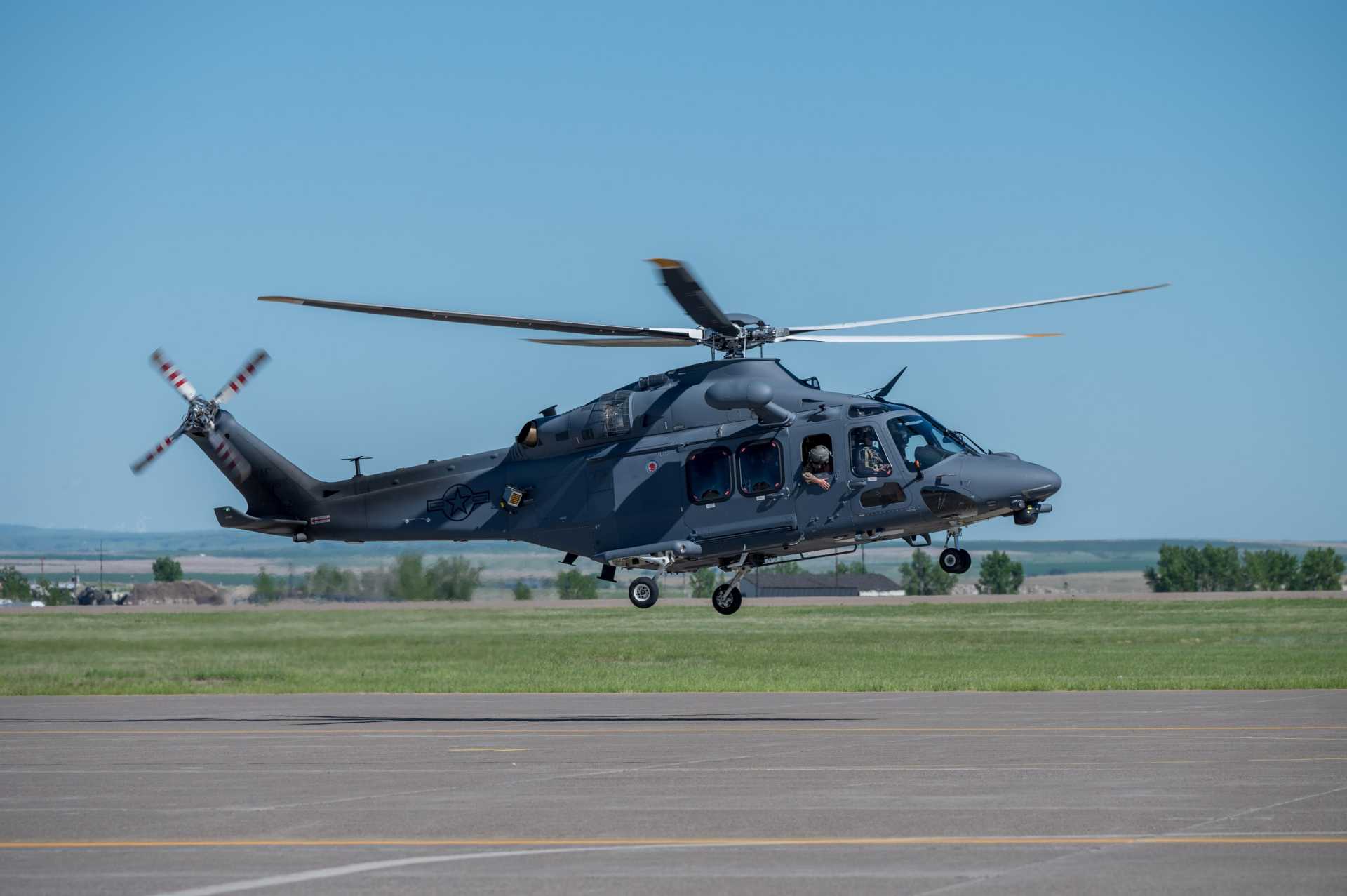Breaking News: U.S. Air Force completes MH-139A Grey Wolf helicopter test to protect Minuteman ICBM missile sites

{loadposition bannertop}
{loadposition sidebarpub}
According to information published by Boeing on July 16, 2025, the United States Air Force has officially completed the final Initial Operational Test and Evaluation (IOT&E) flight of the MH-139A Grey Wolf helicopter, concluding a comprehensive six-month test campaign that validated the aircraft’s operational effectiveness, maintainability, and mission suitability. This critical milestone paves the way for a full-rate production decision, advancing the U.S. Air Force’s efforts to modernize its strategic airlift capabilities for nuclear security and other national defense missions.Follow Army Recognition on Google News at this link
The MH-139A Grey Wolf is a multi-mission military helicopter developed by Boeing and based on the Leonardo AW139 platform. Designed to replace the aging UH-1N Huey, it provides enhanced speed, range, and survivability to protect US Air Force Minuteman intercontinental ballistic missile sites and support critical national defense operations. (Picture source: Boeing Defense)
Throughout the IOT&E (Initial Operational Test and Evaluation ) phase, the U.S. Air Force MH-139A helicopter underwent an intensive series of assessments simulating real-world conditions, including convoy escort, airfield patrol, security force transport, and logistical sustainment operations. The evaluation validated not only the performance characteristics of the Grey Wolf but also its maintenance routines, support infrastructure, and supply chain integration. These trials confirmed that the platform meets the Air Force’s stringent operational readiness criteria and can be reliably sustained in demanding environments. The sustainment effort focused on creating robust support systems to ensure mission availability, minimize downtime, and maximize lifecycle efficiency.
The MH-139A Grey Wolf is a militarized variant of the commercial Leonardo AW139 twin-engine helicopter, modified and produced by Boeing to fulfill the Air Force Global Strike Command’s requirement for a faster, more survivable, and mission-flexible replacement of the aging UH-1N Huey. Compared to its predecessor, the Grey Wolf offers 50 percent faster cruise speed, 50 percent greater range, a 30 percent larger cabin, and a 5,000-pound higher payload capacity. The helicopter features advanced avionics, full autopilot capability, ballistic protection, crashworthy fuel systems, integrated missile warning sensors, electronic countermeasures, and provisions for two externally mounted M240 machine guns.
Its primary mission is to provide rapid-reaction airlift and armed escort for the protection of the United States’ Minuteman III LGM-30 land-based intercontinental ballistic missile (ICBM) infrastructure across strategic locations such as Malmstrom Air Force Base in Montana, Minot AFB in North Dakota, and F.E. Warren AFB in Wyoming. It will also support the deployment of tactical response teams, conduct aerial patrols of missile fields, and respond to potential security breaches. The platform’s capabilities were tested in realistic nuclear security operational environments during the IOT&E campaign, ensuring its ability to integrate into and enhance existing missile defense protocols.
Beyond its role in nuclear deterrence operations, the MH-139A will perform a range of secondary missions including VIP transport, medical evacuation, aircrew survival training, emergency disaster response, and conventional airlift duties. It will serve under multiple commands including the Air Force District of Washington, Air Education & Training Command, Air Force Materiel Command, and Pacific Air Forces. Training operations are currently being conducted by the 908th Flying Training Wing at Maxwell AFB, which operates the 703rd and 24th Helicopter Squadrons designated to lead MH-139 mission training and readiness development.
The U.S. Air Force’s acquisition strategy for the MH-139A began with a $285 million contract awarded in September 2018 for the first 13 aircraft, associated training systems, and ground support equipment under a Low-Rate Initial Production (LRIP) Lot 1 agreement. Following successful milestones, LRIP Lot 2 was approved in April 2023 for an additional 13 helicopters, with the aircraft to be delivered to Malmstrom and Maxwell AFB. In April 2024, Boeing secured a further $178 million contract to supply seven more MH-139As along with training and sustainment services, bringing the total ordered to 33 units under the initial program scope. The broader acquisition framework allows for up to 84 MH-139A helicopters, with a total projected value of approximately $2.38 billion.
Now that the IOT&E phase is concluded, the U.S. Air Force will conduct a final review of operational data of MH-139A helivcopter to issue a formal recommendation for full-rate production. This transition will allow the program to shift from low-rate deliveries to scaled manufacturing and fielding across designated operational wings. The MH-139A Grey Wolf helicopter is set to become a cornerstone platform in the modernization of the Air Force’s nuclear security and rapid-response aviation fleets, embodying next-generation capabilities essential for mission assurance in the 21st-century strategic defense environment.

{loadposition bannertop}
{loadposition sidebarpub}
According to information published by Boeing on July 16, 2025, the United States Air Force has officially completed the final Initial Operational Test and Evaluation (IOT&E) flight of the MH-139A Grey Wolf helicopter, concluding a comprehensive six-month test campaign that validated the aircraft’s operational effectiveness, maintainability, and mission suitability. This critical milestone paves the way for a full-rate production decision, advancing the U.S. Air Force’s efforts to modernize its strategic airlift capabilities for nuclear security and other national defense missions.
Follow Army Recognition on Google News at this link
The MH-139A Grey Wolf is a multi-mission military helicopter developed by Boeing and based on the Leonardo AW139 platform. Designed to replace the aging UH-1N Huey, it provides enhanced speed, range, and survivability to protect US Air Force Minuteman intercontinental ballistic missile sites and support critical national defense operations. (Picture source: Boeing Defense)
Throughout the IOT&E (Initial Operational Test and Evaluation ) phase, the U.S. Air Force MH-139A helicopter underwent an intensive series of assessments simulating real-world conditions, including convoy escort, airfield patrol, security force transport, and logistical sustainment operations. The evaluation validated not only the performance characteristics of the Grey Wolf but also its maintenance routines, support infrastructure, and supply chain integration. These trials confirmed that the platform meets the Air Force’s stringent operational readiness criteria and can be reliably sustained in demanding environments. The sustainment effort focused on creating robust support systems to ensure mission availability, minimize downtime, and maximize lifecycle efficiency.
The MH-139A Grey Wolf is a militarized variant of the commercial Leonardo AW139 twin-engine helicopter, modified and produced by Boeing to fulfill the Air Force Global Strike Command’s requirement for a faster, more survivable, and mission-flexible replacement of the aging UH-1N Huey. Compared to its predecessor, the Grey Wolf offers 50 percent faster cruise speed, 50 percent greater range, a 30 percent larger cabin, and a 5,000-pound higher payload capacity. The helicopter features advanced avionics, full autopilot capability, ballistic protection, crashworthy fuel systems, integrated missile warning sensors, electronic countermeasures, and provisions for two externally mounted M240 machine guns.
Its primary mission is to provide rapid-reaction airlift and armed escort for the protection of the United States’ Minuteman III LGM-30 land-based intercontinental ballistic missile (ICBM) infrastructure across strategic locations such as Malmstrom Air Force Base in Montana, Minot AFB in North Dakota, and F.E. Warren AFB in Wyoming. It will also support the deployment of tactical response teams, conduct aerial patrols of missile fields, and respond to potential security breaches. The platform’s capabilities were tested in realistic nuclear security operational environments during the IOT&E campaign, ensuring its ability to integrate into and enhance existing missile defense protocols.
Beyond its role in nuclear deterrence operations, the MH-139A will perform a range of secondary missions including VIP transport, medical evacuation, aircrew survival training, emergency disaster response, and conventional airlift duties. It will serve under multiple commands including the Air Force District of Washington, Air Education & Training Command, Air Force Materiel Command, and Pacific Air Forces. Training operations are currently being conducted by the 908th Flying Training Wing at Maxwell AFB, which operates the 703rd and 24th Helicopter Squadrons designated to lead MH-139 mission training and readiness development.
The U.S. Air Force’s acquisition strategy for the MH-139A began with a $285 million contract awarded in September 2018 for the first 13 aircraft, associated training systems, and ground support equipment under a Low-Rate Initial Production (LRIP) Lot 1 agreement. Following successful milestones, LRIP Lot 2 was approved in April 2023 for an additional 13 helicopters, with the aircraft to be delivered to Malmstrom and Maxwell AFB. In April 2024, Boeing secured a further $178 million contract to supply seven more MH-139As along with training and sustainment services, bringing the total ordered to 33 units under the initial program scope. The broader acquisition framework allows for up to 84 MH-139A helicopters, with a total projected value of approximately $2.38 billion.
Now that the IOT&E phase is concluded, the U.S. Air Force will conduct a final review of operational data of MH-139A helivcopter to issue a formal recommendation for full-rate production. This transition will allow the program to shift from low-rate deliveries to scaled manufacturing and fielding across designated operational wings. The MH-139A Grey Wolf helicopter is set to become a cornerstone platform in the modernization of the Air Force’s nuclear security and rapid-response aviation fleets, embodying next-generation capabilities essential for mission assurance in the 21st-century strategic defense environment.





